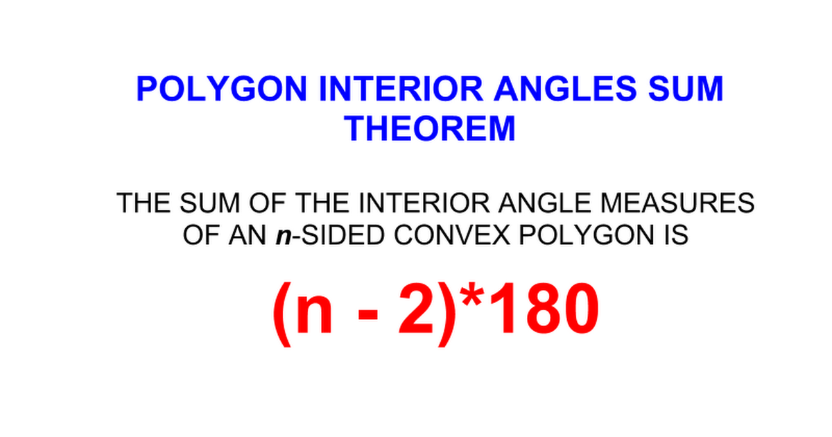Finding the Sum of the Interior Angles of Pentagons
In order to find the interior angles of a pentagon, we must first specify what exactly is being meant by interior as well as exterior and take a look back at triangles.
In the interactive diagram above, the pink shaded portion is the exterior angle as it is the angle on the exterior of the shape.
As for the interior, that would represent the blue shaded angle, as it is inside of the shape.
Furthermore, both sides of the exterior and interior of a triangle will always add up to 180.
For this lesson, we will mainly be focusing on interior angles.
Move around the top of the triangle to see that in action!
----------------------------------------------------------------------------------------------------------------------
Let's have another look at triangles again.
Try and move each triangle to your heart's content.
Although each triangle looks vastly different, do you notice what amount the interior angles always equals to? Try adding them and find out!
The sum of the angles equals to?
Yep, no matter how you move it, a triangle will always equal to 180.
Now that you're a triangle master, let's add one more vertex point (the dots) and turn these triangles into a square and rhombus.
----------------------------------------------------------------------------------------------------------------------
For this next part, you will have two triangles and you will check to see if you can pair them up to make either a square or rhombus.
(Hint: If you're having trouble, try flipping one of the triangles upside down then connecting and squeezing them together.)
(Spoilers)
So in the end, the two triangles put together should like something like one of the two...
Did you come to a similar conclusion? It's pretty interesting to see how two triangles can make a square like shape, isn't it?
Now that we know two triangles can be fit into making a square, remember how the sum of the interior angles of a triangle equals 180? Since it's two triangles to make a square we are dealing with, we would double the amount of the sum of the interior triangles to find the sum of the square.
Let's take a look at the following example to get a better look at this.
----------------------------------------------------------------------------------------------------------------------
And so the complete shapes would simply look like...
And so with the description above and with the use of the shapes, If you were to add all of the measurements together, then for both shapes what would you get?
You would get?...
So from here, what do you suppose would happen if you added yet another triangle? There's a few shapes it can turn into actually but one way turns into a familiar shape...
----------------------------------------------------------------------------------------------------------------------
Well would you look at that, it turns into an octagon!
Now given what we know about the sum of the interior angles of a triangle (180) and the sum of the interior angles of a square (360) what do you think the sum of the interior angles of this shape would turn out to be? Take a wild guess.
I think it would be...
----------------------------------------------------------------------------------------------------------------------
Well, in order to find this, I will now present a formula in order to find the sum of the interior angles that will be true for any given polygon or n-gon.

. Remember that and remember it well. And as for what it stands for,
The n - 2 is the number of sides that the n-gon has subtracted by 2 and 180 is the sum of the interior angles of a triangle- being 180° .
So, now that you know the formula, let's get back to finding the interior angles of a pentagon and see if you were right!
----------------------------------------------------------------------------------------------------------------------
Let's start then by counting the number of sides the shape has then.
So as we can clearly see, this shape has 5 sides.
So from here I'll leave you to it to plug in the amount of sides (n) into the formula to find your answer.
After using the formula, I found my answer to be?...
Once you have your answer, continue onwards.
----------------------------------------------------------------------------------------------------------------------
And there you have it! You have now found the sum of the interior angles of a pentagon!
540°.
Hopefully with this new formula that you have now discovered,you can now find what the interior angles of any pentagon and n-gon that come your way are easily. With that being said, could you kindly remind me what the formula was again? Thanks in advance!
Yes, the formula for finding the interior angles of an n-gon was...